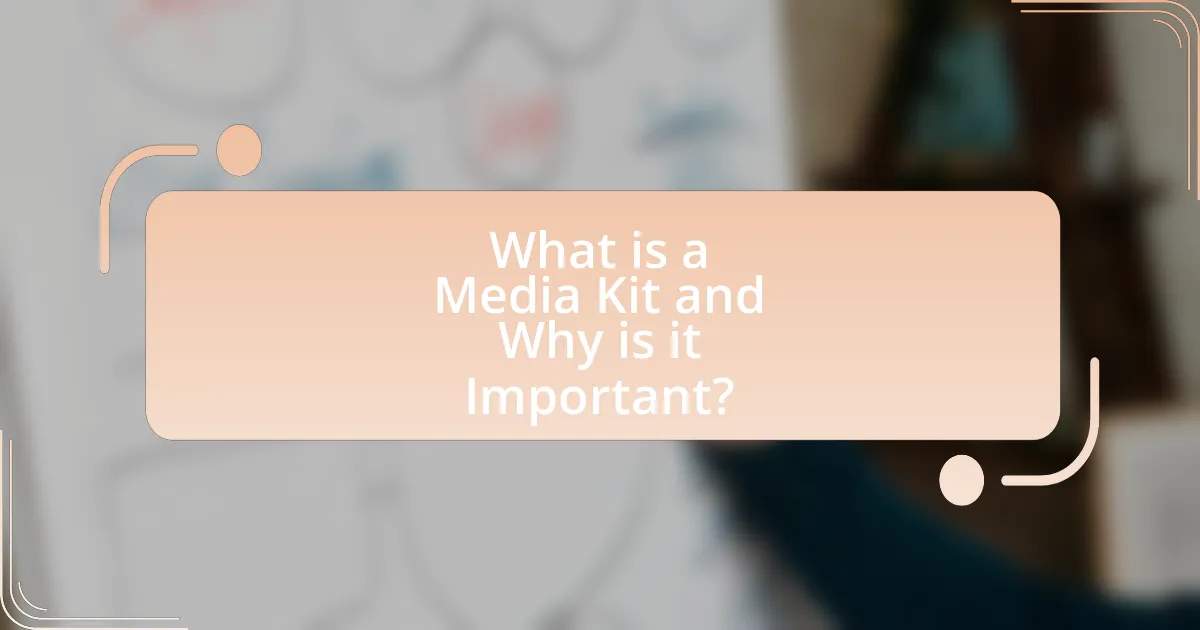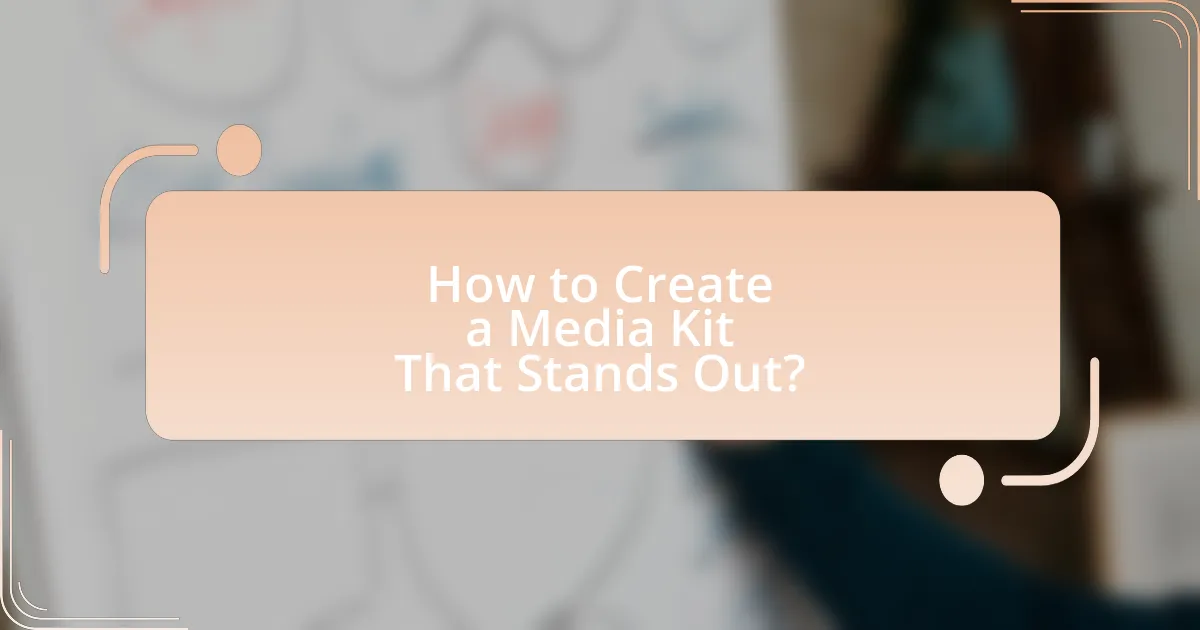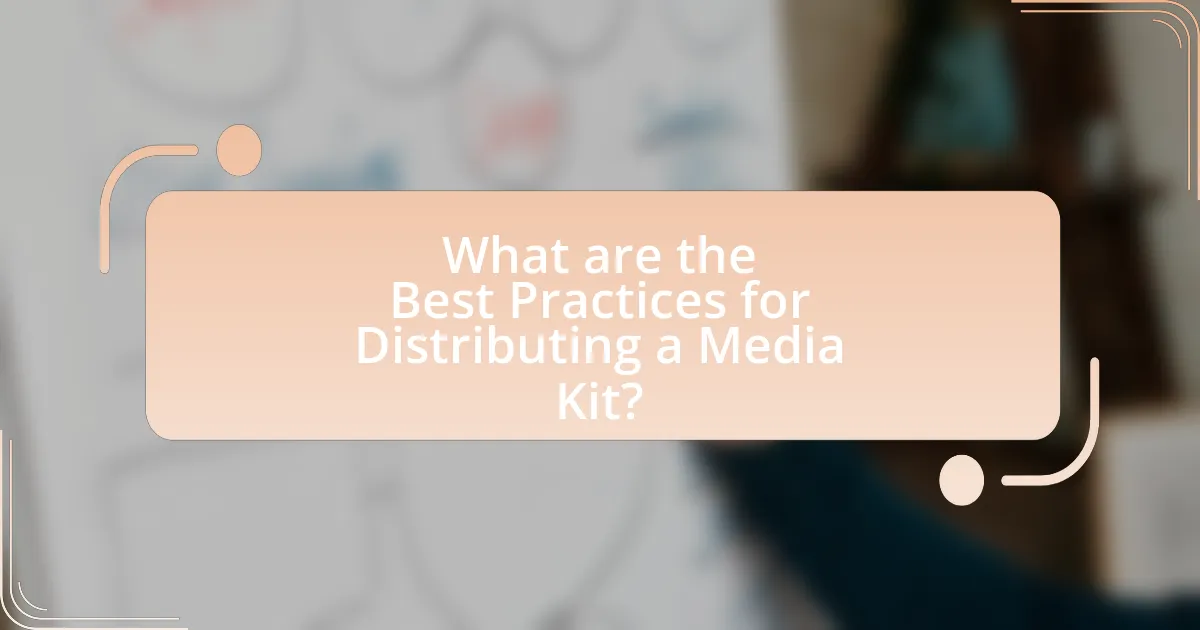A media kit is a vital collection of promotional materials that provides essential information about a brand, organization, or individual to media professionals. This article outlines the importance of media kits, detailing their benefits for businesses and individuals, essential components, and best practices for creating an effective kit. Key elements include company overviews, press releases, high-resolution images, and contact information, all designed to enhance brand visibility and facilitate media outreach. Additionally, the article discusses strategies for distribution, follow-up techniques, and metrics for measuring effectiveness, emphasizing the need for clarity, conciseness, and audience tailoring to ensure a standout media kit.

What is a Media Kit and Why is it Important?
A media kit is a collection of promotional materials that provides essential information about a brand, organization, or individual to media professionals. It is important because it serves as a comprehensive resource that helps journalists and influencers understand the key messages, values, and offerings of the entity, facilitating effective communication and coverage. Media kits typically include press releases, high-resolution images, bios, and contact information, which streamline the process for media outlets and enhance the likelihood of positive exposure.
How does a Media Kit benefit businesses and individuals?
A Media Kit benefits businesses and individuals by providing a comprehensive overview of their brand, products, and services, which facilitates effective communication with potential partners, clients, and the media. This toolkit typically includes essential information such as company background, key achievements, target audience, and contact details, enabling stakeholders to quickly understand the value proposition. Research indicates that 70% of journalists prefer receiving a Media Kit when considering coverage, highlighting its importance in establishing credibility and fostering relationships.
What essential elements should be included in a Media Kit?
A Media Kit should include essential elements such as a company overview, key statistics, product or service descriptions, high-resolution images, press releases, and contact information. The company overview provides context about the brand, while key statistics offer insights into audience reach and engagement, which are crucial for media professionals. Product or service descriptions detail offerings, and high-resolution images enhance visual appeal. Press releases keep media updated on newsworthy events, and contact information ensures easy communication. These components collectively create a comprehensive resource for journalists and influencers, facilitating effective media outreach.
How does a Media Kit enhance brand visibility?
A Media Kit enhances brand visibility by providing a comprehensive and visually appealing presentation of a brand’s identity, offerings, and achievements. This tool effectively communicates key information to potential partners, media outlets, and consumers, making it easier for them to understand the brand’s value proposition. For instance, a well-designed Media Kit can include high-quality images, press releases, and case studies, which can increase the likelihood of media coverage and partnerships. Research indicates that brands with professional Media Kits are 70% more likely to attract media attention compared to those without, demonstrating the significant impact of this resource on brand visibility.
What are the key components of an effective Media Kit?
An effective Media Kit includes several key components: a company overview, press releases, high-resolution images, bios of key team members, product or service information, and contact details. The company overview provides essential background and context, while press releases highlight recent news or achievements. High-resolution images are crucial for media use, ensuring quality representation. Bios of key team members offer insight into expertise and credibility. Detailed product or service information helps journalists understand offerings, and clear contact details facilitate easy communication. These components collectively enhance the Media Kit’s effectiveness by providing comprehensive and accessible information for media professionals.
What role does a press release play in a Media Kit?
A press release serves as a critical component of a Media Kit by providing journalists and media outlets with essential information about a company, product, or event. It succinctly conveys key messages, highlights newsworthy aspects, and offers background information that can facilitate media coverage. The inclusion of a press release in a Media Kit ensures that media professionals have access to a well-structured narrative, which can enhance the likelihood of coverage and engagement. This is supported by the fact that 70% of journalists prefer receiving press releases as part of a Media Kit, as it streamlines their research process and aids in crafting stories.
How can visuals improve the impact of a Media Kit?
Visuals enhance the impact of a Media Kit by capturing attention and conveying information quickly and effectively. Research indicates that people process visuals 60,000 times faster than text, making images, infographics, and videos crucial for engaging audiences. For instance, a study by 3M Corporation found that visuals improve retention rates by up to 65%, which underscores their importance in ensuring that key messages are remembered. Additionally, well-designed visuals can help to establish brand identity and credibility, as consistent imagery reinforces recognition and trust among potential clients and partners.

How to Create a Media Kit That Stands Out?
To create a media kit that stands out, focus on clear, visually appealing design and concise, impactful content. A standout media kit should include essential elements such as a compelling introduction, high-quality images, key statistics about your audience, and testimonials or case studies that highlight your achievements. According to a study by HubSpot, 70% of marketers believe that visual content is essential for engaging their audience, which underscores the importance of design in your media kit. Additionally, including a call to action can guide potential partners or clients on the next steps, making your media kit not only informative but also actionable.
What steps should be followed to design a standout Media Kit?
To design a standout Media Kit, follow these steps: first, define your target audience to tailor the content effectively. Next, include a compelling introduction that outlines your brand’s mission and values. Then, present high-quality visuals, such as logos and images, to enhance visual appeal. After that, provide detailed information about your products or services, including key features and benefits. Additionally, incorporate testimonials or case studies to build credibility. Finally, ensure that your contact information is clear and accessible for potential collaborations. These steps are essential as they create a cohesive and engaging Media Kit that effectively communicates your brand’s message.
How can storytelling be incorporated into a Media Kit?
Storytelling can be incorporated into a Media Kit by weaving a compelling narrative that highlights the brand’s mission, values, and unique selling points. This narrative can be presented through case studies, testimonials, and engaging visuals that illustrate the brand’s journey and impact. For instance, including a success story that showcases how the brand solved a specific problem for a customer can create an emotional connection and enhance relatability. Research indicates that narratives are 22 times more memorable than facts alone, emphasizing the effectiveness of storytelling in capturing attention and fostering engagement.
What design elements are crucial for a visually appealing Media Kit?
Key design elements crucial for a visually appealing Media Kit include a cohesive color scheme, high-quality images, clear typography, and well-structured layouts. A cohesive color scheme enhances brand identity and ensures visual harmony, while high-quality images capture attention and convey professionalism. Clear typography improves readability and guides the viewer’s eye, and well-structured layouts facilitate easy navigation of information. These elements collectively contribute to a polished and engaging presentation, which is essential for effectively communicating a brand’s message.
What common mistakes should be avoided when creating a Media Kit?
Common mistakes to avoid when creating a Media Kit include lack of clarity, outdated information, and poor design. Clarity is essential; a Media Kit should clearly communicate the brand’s message and offerings. Outdated information can mislead potential partners or clients, so it is crucial to keep all data current, including statistics and contact details. Additionally, poor design can detract from the professionalism of the Media Kit; a visually appealing layout enhances readability and engagement. According to a study by the Nielsen Norman Group, users often judge a website’s credibility based on its design, which can be extrapolated to Media Kits as well.
How can clarity and conciseness improve a Media Kit?
Clarity and conciseness significantly enhance a Media Kit by ensuring that key information is easily understood and quickly accessible. When a Media Kit presents information clearly, it allows journalists and potential partners to grasp the essential details without confusion, which increases the likelihood of engagement. Conciseness eliminates unnecessary jargon and filler content, making the kit more appealing and efficient for busy professionals who may only skim the material. Research indicates that clear and concise communication improves retention and comprehension, which is crucial in a competitive media landscape where attention spans are limited.
Why is it important to tailor a Media Kit to the target audience?
Tailoring a Media Kit to the target audience is crucial because it ensures that the content resonates with the specific interests and needs of that audience. When a Media Kit is customized, it increases the likelihood of engagement and positive response, as it addresses the unique preferences and expectations of the recipients. For instance, research indicates that targeted messaging can improve response rates by up to 300%, highlighting the effectiveness of personalization in communication strategies. Therefore, a well-tailored Media Kit not only captures attention but also enhances the potential for successful partnerships and collaborations.

What are the Best Practices for Distributing a Media Kit?
The best practices for distributing a media kit include targeting the right audience, utilizing multiple channels, and ensuring accessibility. Targeting the right audience involves identifying journalists, influencers, and media outlets that align with the brand’s message, which increases the likelihood of coverage. Utilizing multiple channels, such as email, social media, and press release distribution services, maximizes reach and engagement. Ensuring accessibility means providing the media kit in various formats, such as PDF and online access, to cater to different preferences. These practices enhance visibility and improve the chances of media coverage, as evidenced by studies showing that targeted outreach can increase media mentions by up to 50%.
How can you effectively share your Media Kit with the media?
To effectively share your Media Kit with the media, utilize email distribution to targeted journalists and influencers. This method allows for direct communication and ensures that your Media Kit reaches individuals who are most likely to be interested in your content. According to a 2021 survey by Cision, 85% of journalists prefer receiving press releases via email, highlighting the effectiveness of this approach. Additionally, consider using a dedicated press page on your website where media representatives can easily access and download your Media Kit, further enhancing visibility and accessibility.
What platforms are best for distributing a Media Kit?
The best platforms for distributing a Media Kit include email, social media, and dedicated press release distribution services. Email allows for direct communication with journalists and influencers, ensuring that the Media Kit reaches the intended audience effectively. Social media platforms like Twitter, LinkedIn, and Facebook enable broader visibility and engagement, allowing for sharing and interaction with a wider audience. Dedicated press release distribution services, such as PR Newswire and Business Wire, provide targeted outreach to media outlets and can enhance the chances of coverage. These platforms are widely recognized for their effectiveness in reaching relevant stakeholders in the media landscape.
How can follow-up strategies enhance Media Kit outreach?
Follow-up strategies can significantly enhance Media Kit outreach by ensuring sustained engagement with potential media contacts. These strategies allow for timely reminders and additional information, which can increase the likelihood of media coverage. Research indicates that consistent follow-up can improve response rates by up to 30%, as it keeps the Media Kit top-of-mind for journalists and influencers. By providing updates or answering questions, follow-ups can also clarify the value of the Media Kit, making it more appealing for coverage.
What tips can help ensure your Media Kit is successful?
To ensure your Media Kit is successful, focus on clarity, professionalism, and relevance. A well-structured Media Kit should include a compelling introduction, high-quality visuals, and concise information about your brand, products, or services. Including statistics about your audience engagement, such as social media followers or website traffic, can validate your reach and influence. Additionally, tailoring the content to the specific media outlet or audience increases the likelihood of capturing attention. Research shows that personalized pitches can improve response rates by up to 50%, highlighting the importance of customization in your Media Kit.
How often should a Media Kit be updated to remain relevant?
A Media Kit should be updated at least annually to remain relevant. Regular updates ensure that the information reflects the latest achievements, statistics, and branding elements. For instance, if a company undergoes significant changes such as a rebranding, new product launches, or shifts in target audience, the Media Kit should be revised immediately to accurately represent the current state of the organization. This practice aligns with industry standards, as many marketing professionals recommend annual reviews to maintain accuracy and effectiveness in communication materials.
What metrics can be used to measure the effectiveness of a Media Kit?
The effectiveness of a Media Kit can be measured using metrics such as engagement rates, reach, conversion rates, and feedback from target audiences. Engagement rates indicate how well the content resonates with the audience, while reach measures the total number of people exposed to the Media Kit. Conversion rates reflect the percentage of viewers who take a desired action, such as signing up for a newsletter or making a purchase. Additionally, qualitative feedback from surveys or interviews can provide insights into the Media Kit’s impact and areas for improvement. These metrics collectively offer a comprehensive view of the Media Kit’s performance and effectiveness in achieving its goals.